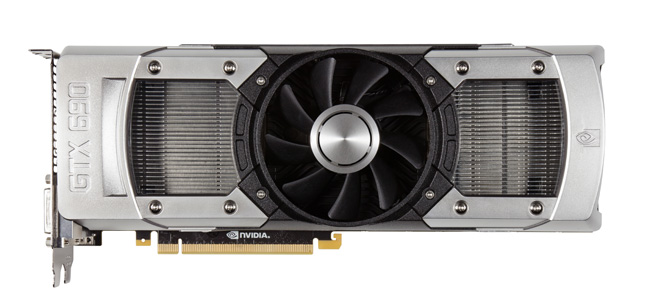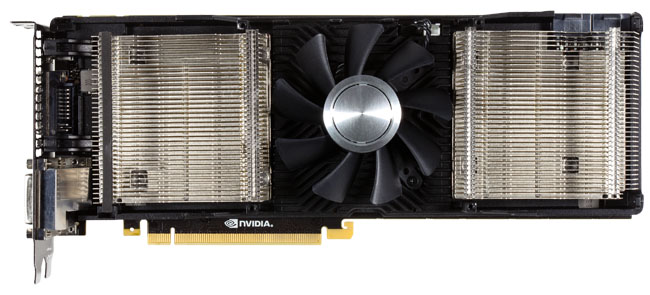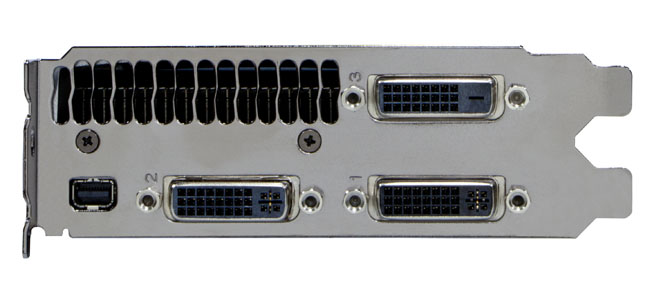Surprisingly elegant design
And thar she blows. Anyone expecting the dual-GPU behemoth to resemble outlandish creations such as the ASUS Mars II are in for a surprise. The GeForce GTX 690, while 11in long, is fashioned with a simple, elegant look and feel. The centrally-mounted axial fan, 80mm in size, is flanked by a couple of vapour-chamber coolers that can be clearly seen through polycarbonate windows.The fan drives air over two heatsinks that each cool a GeForce GTX 680 GPU. You'll notice that each cooler is comfortably smaller than that found on the single-GPU card, and the whole shebang is made possible by reducing the power-draw characteristics of each full-fat GPU. Understanding that 300W has to be dissipated on a regular basis and relative quietness is almost as important as overall performance, NVIDIA says its engineers have spent considerable time fine-tuning the way in which the fan-generated airflow strikes the fins on each heatsink, with the aim of keeping noise levels in check.
Strip both coolers away and the GTX 690 is revealed. The two GTX 680 GPUs are spaced nicely apart - remember, they operate at almost single-GPU speeds once GPU Boost is factored in - and hooked up via a switch chip from PLX. Located by the left-hand GPU, the PEX8747, sometimes found on ultra-high-end motherboards, provides the internal SLI trickery that connects each GPU to the system. This PCIe Gen 3 switch provides up to 8 gigatransfers per second (GT/s) of bandwidth, which is more than offered up by all but the latest motherboards. SLI performance should be about as good as it gets, then.
Each GPU has access to its own 2GB of GDDR5 memory - eight 256Mbit chips - that runs at an effective 6,008MHz, meaning it is no different to a regular GTX 680. The GPUs cannot use each other's framebuffer, mind, so the few gaming situations in which the single-GPU 680 runs out of onboard memory are liable to be replicated here.
Look top-left and a single SLI finger comes into focus. Add a second card to a system and four-way SLI is achievable on a motherboard with two PCIe x16 slots, This means most mid-range motherboards are capable of running silly-fast graphics, thus taking the shine away from ultra-enthusiast boards whose raison d'etre is, well, running silly-fast graphics through three or four single-GPU boards. We're sure ASUS, MSI and Gigabyte will thank NVIDIA for this.
Powering the beast are two 8-pin PEG connectors on the top-right. Each can provide 150W of juice and any motherboard based on PCIe 2.1 spec, or later, can supply an additional 150W. Therefore there's ample power headroom to push the card's cooling to the limit. The GTX 690 works in the same fashion as the GTX 680, that is, the Power Target can be increased by around 33 per cent above stock. Read between the lines, this means the card can pull significantly more than 300W. We recommend potential purchasers have a decent 600W-plus PSU in their machines, one with plenty of amps on the 12V rail(s).
Here's one change from GTX 680. This card retains the four-screen video-output ability but swaps out the HDMI port for dual-link DVI. We reckon folk intent on three-screen gaming may just prefer three identical connectors that can run a trio of 2,560x1,600-resolution monitors without having to trouble the DisplayPort interface on the left - the GTX 680's HDMI can push out a maximum resolution of 1080p.
Adding some bling, the GeForce GTX name on the near side of the card lights up rather nicely when powered in a system. A bunch of LEDs housed behind the laser-etched letters provide the NVIDIA green glow, though it's about as useful as a one-legged man in an earthquake if you don't have a windowed side panel.
And the most boring picture finishes off the card-examination page.















